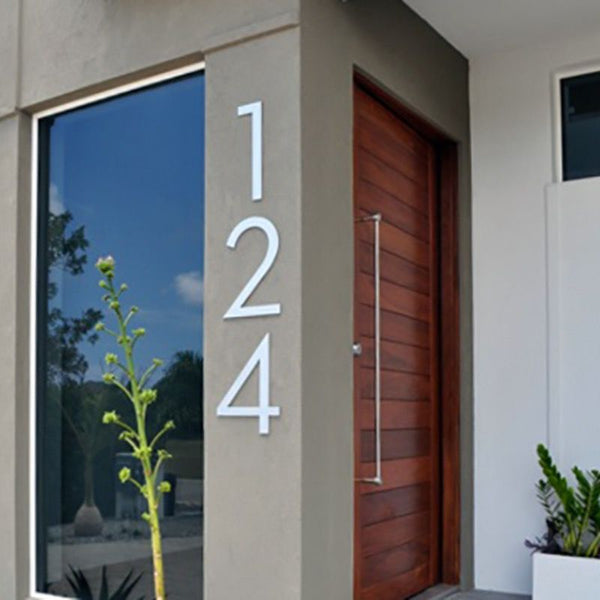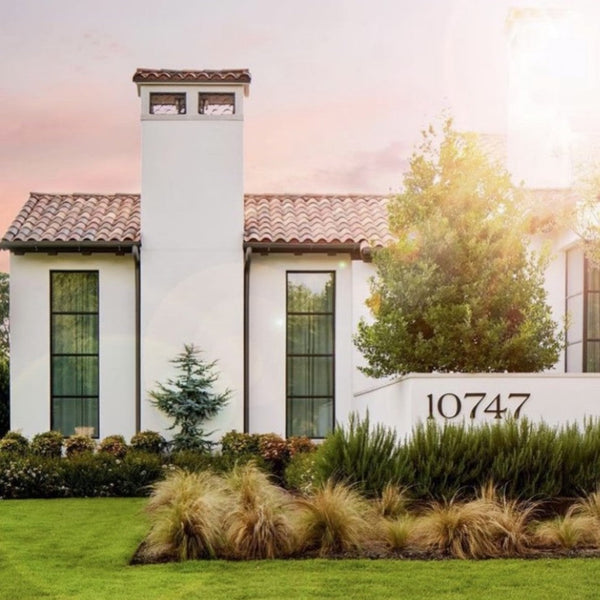
House numbers are the numeric (or alphanumeric) identifiers assigned to individual buildings, residential or commercial, along streets or within neighborhoods, forming part of a postal address. They exist to help locate properties efficiently, guide postal mail delivery, and assist emergency services, visitors, and municipal administration. For example, by the early 1870s, London had renumbered some 100,000 houses under new regulations.
This article aims to trace the development of house numbering over time, beginning with early numbering efforts in Europe in the 18th century and continuing to modern systems. It also explores how house numbers have become a crucial yet often overlooked element in urban design, navigation, and address systems, often leading people to everything you need to know about ordering custom house numbers.
Along the way, we’ll examine key moments, such as the decree by Louis XV in France or the London reforms of the mid-19th century, and explore how house numbering influences contemporary architectural and planning practices.
What Are House Numbers and Why Were They Invented?
House numbers are structured identifiers assigned to buildings along streets, forming part of a property’s official address. Their primary role is to make individual properties easier to locate, ensuring that deliveries, visitors, and emergency responders can find the right place without confusion.
Historically, however, house numbers were not introduced solely for convenience. Emergency medical services typically take an average of 7 minutes from the time of a 911 call to arrival on the scene in urban areas, but this median time increases to more than 14 minutes in rural settings. They served multiple civic and administrative functions, including:
- Identification: Enabling towns and cities to distinguish one building from another within growing settlements.
- Taxation: Helping governments track properties for census records and levy household or property taxes fairly.
- Deliveries and communication: Supporting postal services as literacy and communication expanded during the 17th and 18th centuries.
- Governance: Assisting city authorities in maintaining order, property registration, and efficient urban planning. For quick updates to existing identifiers, many property owners find the easy mailbox makeover install decals in minutes a convenient and practical solution.
According to a study by Oxford University Press on urban administration, house numbering in Europe became widespread in the 18th century as governments sought more effective systems of control and taxation. This highlights how numbering, though commonplace today, was originally a tool of bureaucracy.
Early Origins of House Numbering in Ancient Times
The concept of assigning identifiers to homes and buildings predates the formal numbering systems seen in Europe. In ancient civilizations, city planning and governance often required ways to distinguish properties.
For example, archaeological studies of the Roman Empire reveal that insulae (apartment blocks) and domus (private houses) were often marked or cataloged for tax and census purposes. Although not identical to modern numbering, these methods laid the groundwork for the structured identification of properties.
In China, early dynasties employed detailed household registration systems, such as the hukou, which recorded families for taxation and military service. While not a physical house number in today’s sense, this system demonstrates how governance relied on associating households with recorded identifiers.
In 2 AD, Qinghe Commandery (清河郡) in northern China had 123,964 registered households under the Han dynasty. A study published by the University of California Press confirms that during the Tang dynasty, household registers formed a foundation of fiscal control.
Medieval Europe:
Medieval Europe also provides glimpses of precursors to numbering. Historical records from Florence and other Italian cities show that properties were described using landmarks or parish identifiers.
By the 13th century, certain cities began to systematically record homes for taxation rolls and census purposes, although numbering was not yet standardized. In the Florentine Catasto of 1427, city officials surveyed 9,780 households.
In 1512, Paris officials conducted a citywide census for tax purposes, cataloging households, though this predated formal house numbering by more than two centuries. This demonstrates the extent to which property identification was already central to governance, even before formal numbering became widespread.
From these examples, it is clear that house numbering as we know it did not emerge suddenly but evolved from earlier administrative practices. Ancient and medieval societies laid the intellectual and practical foundations, which Europe later formalized into the numbered streets and buildings familiar today.You may also be interested in how connected numbers and symbols can give your residence a distinctive, classic-meets-modern aesthetic.
House Numbering in Europe During the 18th Century
The practice of systematically numbering houses in Europe gained momentum during the 18th century, as governments sought more efficient methods to manage census-taking, taxation, and military conscription. Austria was among the earliest adopters, introducing mandatory house numbering in 1770 under Empress Maria Theresa.
This reform was directly tied to military needs, as accurate registers of households allowed the Habsburg Empire to improve recruitment and levy troops more effectively. Each property was assigned a unique number painted on its facade, creating one of the first standardized systems on the continent. During the 1770-72 Habsburg conscription and house-numbering campaign in Bohemia, 389,148 houses were assigned consecutive “conscription” numbers.
France:
France followed closely. During the 1770s, King Louis XV ordered buildings in Paris and other cities to be numbered. The purpose was both administrative and military, enabling officials to track male residents for conscription while also streamlining tax collection.
Within just a few years, numbers spread across French towns, forming an essential part of urban governance. Records from the French National Archives indicate that by 1779, entire districts of Paris had already been fully numbered, making it easier for authorities to control and regulate city life.
England:
England adopted numbering somewhat later but equally systematically. London introduced formal numbering practices in the 1760s as postal services expanded. By the mid-19th century, house numbers were legally regulated under urban improvement acts, ensuring that every building carried a visible identifier.
By the end of the 18th century, house numbering had transformed European cities. It no longer served only bureaucratic and military purposes but also became an essential feature of urban order, commerce, and communication. This model would soon influence other regions of the world.
Spread of House Numbering to America
The introduction of house numbering in America reflected both European influence and the unique needs of rapidly growing colonial cities. Philadelphia is credited with being one of the first U.S. cities to implement house numbers, which it did around 1790.
The system was linked to orderly urban planning and postal service efficiency, ensuring that properties in newly developed blocks could be located without confusion.
Philadelphia:
Based on historical records from the Library of Congress, city directories published in Philadelphia during the 1790s already contained numbered street addresses, indicating that the system had been widely adopted by the close of the 18th century. The first federal census takers in 1790 counted 44,096 residents in the city of Philadelphia and its adjacent suburbs of Southwark and the Northern Liberties, making it the most populous urban center in the new nation.
New York:
New York City adopted numbering in the early 19th century as its population grew rapidly. The famous 1811 Commissioners’ Plan, which laid out the city’s grid system, incorporated a systematic street and building identification system. This not only supported urban development but also allowed the postal service to deliver with greater accuracy.
A report from the New York City Department of Records highlights that by the 1820s, numbering was standard in Manhattan, and directories listed thousands of numbered properties.
Boston, Baltimore, and Washington, D.C.
Boston, Baltimore, and Washington, D.C., soon followed, each adopting numbering schemes during the first half of the 19th century. These systems were primarily motivated by the expansion of postal services and the need for effective municipal governance.
The establishment of the United States Post Office Department in 1792 created a strong incentive for consistency and reliability. As the agency expanded its reach, it relied on numbered addresses to manage delivery routes and ensure that correspondence reached its intended destination. This historical need for reliability is reflected today in the popularity of specialized products like top 5 benefits of using vinyl mailbox number decals for clear communication with delivery services.
By the 1860 census, over 31 million Americans were recorded, and numbering had become indispensable for census officials tasked with identifying and cataloging households across urban centers. For those wanting fast and clear home identification
Chicago:
One unique aspect of American numbering was its integration with the grid plan. Unlike many European cities, which retrofitted numbers onto irregular medieval street patterns, U.S. planners could design entire districts with consistent numbering from the start. This not only simplified navigation but also facilitated real estate development and property sales.
For example, Chicago’s 1909 street renumbering plan established a uniform system in which house numbers increased systematically in every direction from a central axis, a model that many other cities later adopted.
By the late 19th century, house numbers had become an entrenched part of American life. They were essential not just for postal services and census-taking but also for emergency response, business directories, and the growing real estate market.
Their adoption highlights how a practice born in 18th-century Europe for taxation and military purposes evolved into a cornerstone of modern urban planning and daily life in the United States.
The Role of Postal Services in Popularizing House Numbers
The rapid expansion of postal services in the 19th century played a central role in standardizing house numbering across cities and towns. Before this era, numbering often varied from one municipality to another, making it difficult for postal workers and residents to navigate growing urban centers.
United States Postal Service:
The establishment of formal postal organizations, such as the United States Postal Service (USPS) in 1792 and the modernization of the Royal Mail in 1840 with the introduction of the Penny Post, transformed how people relied on accurate addresses. To handle increasing mail volumes, these institutions demanded consistency in how streets and buildings were identified.
Expansion of Routes:
In the U.S., the USPS expanded delivery routes dramatically in the mid-19th century. By 1860, the agency was handling more than seventy-eight million pieces of mail annually, a volume that required precise house numbering to ensure timely delivery.
Similarly, the Royal Mail introduced uniform systems of numbering to accompany its standardized postal districts. This allowed mail carriers to deliver across London and other cities with far greater efficiency, while also ensuring that residents and businesses could be reached reliably.
Changes in House Numbering Systems Have Developed Over Time
As urban growth continued, house numbering evolved from simple painted marks into organized systems designed for clarity and navigation. Early numbering often followed inconsistent patterns, with numbers restarting in each block or assigned sequentially without regard to street layout. These practices created confusion, especially as cities expanded and streets lengthened. By the mid-19th century, reforms introduced systematic approaches. Cities began to assign numbers along entire streets rather than by block. Municipal governments increasingly adopted the odd and even side convention, which quickly became a standard in Europe and North America.
If you are looking to update an older system, you can learn how to upgrade your home with ready-to-ship numbers to bring clarity to your address immediately. At the same time, numbers were arranged to follow the direction of travel along the street, ensuring logical sequences that aided both mail carriers and residents
Odd and Even Numbering on Streets
The convention of placing odd numbers on one side of a street and even numbers on the opposite side emerged in the 19th century as a practical solution for postal workers and urban navigation. Without such a division, numbers often ran sequentially along one side and then continued back along the other, creating unnecessary confusion.
The odd-even system enabled carriers to deliver more efficiently by instantly knowing which side of the street a number belonged to. This arrangement also helped emergency services locate properties more quickly, reducing the likelihood of misdirection.
According to guidelines from the U.S. Department of Transportation, odd numbers are typically assigned to the left side of the street and even numbers to the right, relative to the direction of travel. This simple rule, now so familiar, became a universal aid to orientation in urban environments. It illustrates how numbering not only served administration but also shaped daily navigation.
Different Systems Across Countries
Despite widespread adoption of standardized numbering, significant variations exist across the world.
- The United States: Most U.S. cities use a grid-based approach, with odd numbers on the left and even numbers on the right. Distances are often measured in fixed increments, meaning addresses can indicate how far along a street a property is located. Chicago and Philadelphia are prime examples of this practical method.
- United Kingdom: In contrast, the U.K. often retains older numbering patterns rooted in historical development. Many towns still feature numbers that run sequentially up one side of the street and then back down the other. Royal Mail accommodates these variations, ensuring mail delivery remains reliable despite irregular layouts.
- Asia: Several Asian countries follow entirely different conventions. In Japan, buildings are numbered not by their street position but by the order in which they were constructed within a district. In South Korea, a shift occurred in 2011 to adopt road-name addressing, aligning more closely with Western practices, but older systems remain in local use.
What Style and Design House Numbers Followed in the 20th Century
The 20th century brought significant changes to the way house numbers were crafted and displayed. No longer viewed solely as functional identifiers, they became design elements that reflected broader architectural and artistic movements.
With the growth of industrial production, materials such as metal alloys, ceramics, and wood became widely available for both decorative and practical use. Homeowners could choose numbers that complemented their building’s style rather than relying on basic painted digits.
Design movements left a clear mark. The mid-century modern era popularized sleek, sans-serif fonts and geometric shapes, often produced in aluminum or stainless steel to align with modernist architecture.
Shifting in Designs:
By the late 20th century, the minimalist trend emphasized clean lines, understated forms, and monochromatic palettes, making numbers blend seamlessly into contemporary facades. At the same time, the industrial style revived the use of rugged metals, exposed screws, and bold typefaces, giving numbers a utilitarian yet artistic character.
These design shifts reflected broader cultural values: efficiency, individuality, and aesthetic harmony. According to the Smithsonian’s National Design Museum, decorative house hardware, including numbers, became part of consumer-driven customization during the mid-1900s, linking personal expression with functional objects.
The 20th century established the idea that house numbers were not just identifiers but also subtle markers of style and identity.
Modern Innovations in House Numbers Today
In the 21st century, house numbers have evolved in response to technological advancements, sustainability concerns, and the need for personalization. One major innovation is the use of LED lighting, which ensures visibility at night while consuming far less energy than traditional bulbs.
The U.S. Department of Energy reports that LEDs use up to 75% less energy and last 25 times longer than incandescent lighting, making illuminated house numbers both eco-friendly and cost-effective.
- Integration with smart home systems is another advancement. Some modern house numbers and letters are designed with Wi-Fi or sensor connectivity, allowing them to sync with smart doorbells, security systems, or lighting schedules. This creates safer and more efficient entryways.
- Manufacturers now also offer QuickShip systems, which enable homeowners to order custom-designed numbers with rapid delivery, reflecting the growing demand for personalization. Choices extend to custom fonts, finishes, and materials, enabling alignment with architectural aesthetics.

- Sustainability has also shaped current trends. Designers are increasingly using recycled aluminum, reclaimed wood, or biodegradable composites, thereby reducing the environmental footprint of decorative hardware.
The Evolution of Plaques and Signs Alongside Numbers
As house numbering became common, plaques and complementary signs developed to enhance visibility and distinction. Initially, numbers were painted directly onto doors or walls; however, as urban centers grew, durability and style became increasingly important. Ceramic tiles, cast-iron plaques, and engraved stone markers became widespread in the 19th century, particularly in Europe, where decorative arts influenced even functional items.
By the 20th century, plaques often included not just numbers but also street names, family names, or even business identities, turning simple identifiers into elements of personalization. Municipal authorities began standardizing sign designs to ensure legibility for postal carriers, census workers, and emergency services.
For example, many U.S. municipalities now require numbers to be at least 4 inches tall and visible from the street, a standard set by the International Property Maintenance Code and promoted through local safety regulations.
A Look at the Cultural and Symbolic Role of House Numbers
House numbers are more than identifiers. In many cultures, these symbols carry deep, symbolic meanings that influence how people feel about their homes. Numerology, for example, assigns personality traits or energies to numbers, suggesting that a home with a certain number might attract prosperity or peace.
In Chinese culture, the number 8 is considered extremely lucky because its pronunciation is similar to the word for wealth, while the number 4 is often avoided because it sounds like the word for death. These beliefs even shape property values, with homes bearing “8” usually selling at a premium in markets like Hong Kong and Singapore.
Similarly, feng shui incorporates house numbers into broader principles of balance and energy flow, encouraging alignment between the number of a property and the aspirations of its residents.
In Western traditions, numerology has long been associated with numbers and their personal significance, with homeowners sometimes requesting specific numbers when properties are renumbered.
The Legacy and Future of House Numbers
From their earliest beginnings as tools of governance and taxation to their role in guiding postal services and shaping urban planning, house numbers have traveled a long and fascinating journey.
What started as a practical necessity has grown into a cultural symbol and, in many cases, a personal design statement. Over time, numbers evolved from painted marks and carved stones into modern plaques, illuminated LED displays, and customized fonts that reflect both tradition and innovation.
At Modern House Numbers, we celebrate this legacy by offering contemporary plaques, signs, and custom designs that honor the history of numbering while embracing modern innovation.
If you are inspired by the past and looking to bring personality and visibility to your home today, explore the possibilities with our collection of contemporary house numbers, plaques, and signs.

Frequently Asked Questions
When were house numbers first introduced?
The earliest known examples of house numbers date back to the 16th and 18th centuries. Historical records indicate that in 1512, Paris officials conducted a citywide census for tax purposes, cataloging households, though as mentioned previously this predated formal house numbering by more than two centuries.
Why did cities start using house numbers?
During the growth of European urban centers, officials recognized the need for a systematic method to identify properties. House numbers were introduced to facilitate the easier collection of taxes, more accurate censuses, and efficient military recruitment.
Which country was the first to require house numbers?
Austria is often credited as the first nation to formally require house numbers. In 1770, under Empress Maria Theresa, the Austrian Empire introduced a decree mandating that every house in her dominions be numbered. This “Conscription Numbering” system served both administrative and military purposes, especially as Austria sought to streamline its conscription process.
How did postal services influence house numbering?
The rise of organized postal services in the 19th century was one of the strongest forces behind the standardization of house numbering. In Britain, the Royal Mail relied on consistent numbers to ensure accurate deliveries in growing cities.
How have house numbers changed in design over time?
In the 19th century, numbers were often painted directly on doors or carved into stone lintels, with a focus on function rather than style. By the 20th century, design movements such as mid-century modern and industrial minimalism influenced house numbers, leading to sleek metal fonts, wood-carved plaques, and ceramic tiles.
In recent decades, technology has introduced LED-lit numbers, customizable fonts, and sustainable materials, such as recycled aluminum.
Do cultural beliefs affect house number choices?
Yes, cultural beliefs strongly shape how house numbers are perceived and even valued. In many Asian countries, feng shui and numerology influence buying decisions, with numbers like eight being associated with wealth and prosperity.



